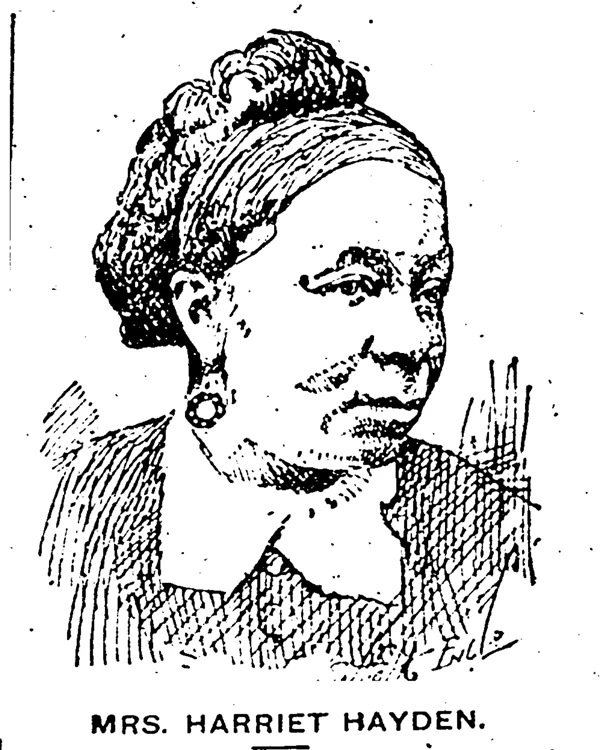Last updated: January 16, 2023
Person
Harriet Hayden

Cleveland Gazette, February 24, 1894
Harriet Bell Hayden, a prominent abolitionist and activist, sheltered freedom seekers in her home on Beacon Hill and dedicated her life to advocating for equal rights for all.
Born into slavery in 1816, Harriet Bell Hayden grew up on a Kentucky plantation. Many details of Harriet Hayden’s early life are unknown. By the time she married Lewis Hayden in 1842, she had one son named Jo. Only a few years after they married, the Haydens escaped slavery with help from abolitionists Calvin Fairbank and Delia Webster.1
The Haydens took a long and risky road to freedom. In 1844, the family traveled by train from Kentucky to Ohio, before crossing the border into Canada.2 Harriet and Lewis Hayden decided that they needed to aid others in their own freedom journeys, and the family returned to the United States in 1845. That same year, Harriet Hayden gave birth to her daughter, Elizabeth. In 1846, the Haydens settled in Boston's Beacon Hill neighborhood. Harriet and Lewis Hayden soon found themselves at the center of Boston's abolitionist movement working with the Vigilance Committee of 1850, which formed to aid and protect people escaping from slavery.3
Harriet Hayden spent over a decade sheltering freedom seekers in the family home, which the Haydens had converted to a boarding house for freedom seekers on the Underground Railroad. While Lewis tended to his responsibilities as a shop owner, Harriet likely took over the day-to-day operation of the boarding house to meet the needs of the freedom seekers who sheltered there, including William and Ellen Craft.4 Harriet Hayden provided her guests with food, shelter, and protection on their dangerous journeys to freedom.
Hayden also used her home as a meeting and organizing space, hosting prominent abolitionists visiting Boston. In 1859, John Brown stayed with the Haydens while preparing for the historic raid on Harpers Ferry, Virginia that same year. Lewis Hayden played a role in recruiting participants and financial backers for the raid, and an obituary for Harriet Hayden noted, "no woman perhaps knew more than she of the inside history of the Harper’s Ferry tragedy."5
Harriet Hayden became a more public figure later in life, as social expectations for women changed. During the Civil War, Hayden and other formerly enslaved Bostonians took classes in reading and writing under the instruction of Mrs. Apphia Howard, a White abolitionist.6 The skills she learned during this period helped her become an even stronger advocate for equal rights.
Harriet and Lewis Hayden committed themselves to a variety of social causes and organizations beyond the Abolitionist movement, including Boston temperance groups and the West End Woman Suffrage League.7 In 1875, Harriet Hayden co-founded the Prince Hall Auxiliary Association to provide an organizing space for female family members of the Prince Hall Masons, a Black masonic society.8 Over the next few years, Hayden led the association in raising funds for a new masonic lodge. In 1876, she organized a celebration for Black Bostonians for the centennial of the American Revolution. Lewis Hayden gave an address at this event, where he praised the women's association's fundraising activities and declared, "the men of Massachusetts owe a debt to you, for, as of yet, they have not recognized your rights… there should be [no rest] until every human being is made equal before the law."9
Harriet Hayden never stopped advocating for the equal rights of Black citizens and Boston's Black community. When she passed away in her home in 1893, Hayden left $5,000 to Harvard University to create a scholarship for Black students pursuing a career in medicine.10
Footnotes
- Stephen Kantrowitz, More Than Freedom: Fighting for Black Citizenship in a White Republic, 1829-1889 (New York: Penguin, 2012), 91.
- Kathryn Grover and Janine V. Da Silva, "Historic Resource Study: Boston African American National Historic Site," Boston African American National Historic Site, (2002), 93-94.
- James Horton and Lois Horton, Black Bostonians: Family Life and Community Struggle in the Antebellum North (New York: Holmes & Meier Publishers, Inc., 1999), 58.
- Stephen Kantrowitz, More Than Freedom, 189.
- The Woman’s Journal 24, no. 52 (December 30, 1893), Schlesinger Library, Radcliffe Institute, Harvard University, accessed July 16, 2022. https://iiif.lib.harvard.edu/manifests/view/drs:49673168$421i
- Stephen Kantrowitz, More Than Freedom, 298.
- The New York Age, November 5, 1887. (accessed July 21, 2022).
- Stephen Kantrowitz, More Than Freedom, 334.
- An account of the labors of the Ladies Charitable Association of Boston, in Recognition of, and Homage to, the Declaration of Independence, (Boston: Wright and Potter), 9.
- Stephen Kantrowitz, More Than Freedom, 421.
